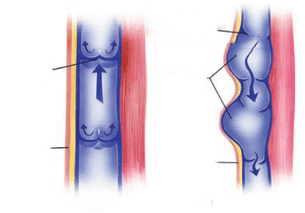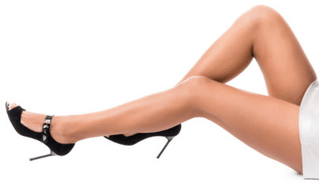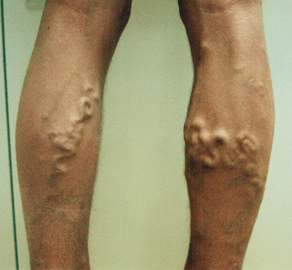
Varicose veins of the legs are a chronic disease. The causes of varicose veins can be hereditary factors, passive lifestyle, heavy loads on the legs and blood vessels. Varicose veins are common during pregnancy.
In pregnant women, the load on the legs increases, swelling often occurs, and against this background, blood clots and other problems with blood vessels can occur, leading to varicose veins.
At the first symptoms of varicose veins (swollen veins, venous network of the legs, severe swelling of the legs, pain in the legs and feet), you should consult a phlebologist. A thorough examination will be needed to establish the diagnosis and extent of varicose veins. After receiving the necessary data, the doctor will tell you how to treat varicose veins in the legs, prescribe the necessary medications and procedures.
Which specialist treats varicose veins?
When varicose veins appear, many patients do not know which doctor treats varicose veins? All vascular diseases are treated by a phlebologist. The phlebologist is a narrow medical specialization that includes diagnosis and treatment of pathological diseases of the veins.
Naturally, a phlebologist should not be visited when varicose veins are in an advanced stage. It is advisable to have a personal phlebologist who can monitor the development of venous diseases at an early stage and prescribe treatment.
If you have varicose veins, it is advisable to contact a venous specialist - phlebologist
Methods for treating varicose veins

Varicose veins belong to the number of unpleasant and dangerous diseases, for the effective treatment of which various means are used. How to treat varicose veins? Varicose veins can be treated by choosing one of several methods.
The choice of treatment for varicose veins depends on the severity of the disease and the individual characteristics of the human body. The procedure for treating varicose veins should be agreed with a doctor. Among the ways to combat diseases of the veins of the legs can be distinguished the following effective methods:
Sclerotherapy
The essence of this technique is that a special substance (sclerosant) is injected into the diseased veins using a thin needle.
Sclerosant, entering the vein, causes the walls to stick together and remove the affected vessel from the common network of blood vessels in the legs.
Sclerotherapy helps to remove small dilated asterisks after 3-5 weeks and after three months the large dilated nodules and bumps will disappear.
Surgical removal of veins (phlebectomy)
This technique is used in severe neglect of varicose veins. Surgery is performed when varicose veins lead to the appearance of large nodules and seals in the vessels, provoking the appearance of huge blood clots. A significant disadvantage of surgery for varicose veins are the scars and scars on the skin.
Laser therapy for varicose veins is used as a convenient and absolutely painless method for dealing with varicose veins. The laser acts on the affected vessel in the same way as the sclerotherapy procedure. The walls of blood vessels under the influence of laser beams are soldered, but it will take a long time for effective treatment of varicose veins. A positive aspect of laser therapy for varicose veins is the lack of scars on the skin.
Hirudotherapy or treatment of varicose veins with leeches. Leeches for varicose veins are often used by adherents of natural medicine. This does not mean that the technique of hirudotherapy is effective, there are many disadvantages. To get a noticeable effect of hirudotherapy, you need to go through several courses, each of which has 8 sessions. Treatment of varicose veins with leeches can be effective only in the initial stage of vascular disease.
Prevention of varicose veins
Varicose veins begin to manifest in the form of severe or episodic pain in the legs, the appearance of a vascular network on the skin of the legs and bulging veins with a blue tinge.
It is advisable to warn varicose veins in advance, rather than then look for different methods to cure it. Here are some precautions you can take to prevent the development of varicose veins.
- Do not wear tight or uncomfortable high-heeled shoes. Uncomfortable shoes increase the pressure in the vessels of the legs, which leads to the formation of blood clots and the development of varicose veins.
- Regular exercise can help you avoid varicose veins. It is recommended to take time every day for walking, running, dancing, swimming. Varicose veins most often develop in salespeople, hairdressers, flight attendants. Why is this trend observed? The legs of people from such professions during the day receive a huge static load as a result of prolonged standing. As a result, the development of varicose veins.
- Body weight should be constantly monitored, as it is the extra pounds that increase the load on the vessels of the legs and increase the blood pressure on the walls.
- It is recommended to regularly organize walks with bare feet on various rough surfaces (pebbles, sand, dry grass). In this way, effective toning of the leg veins is achieved, while at the same time the leg muscles relax and rest well.
- Do not consume salty and spicy foods, alcoholic beverages often. All spicy and salty foods contribute to the formation of blood clots in the vessels and the development of varicose veins. You can dilute thick blood with plain water or unsalted tomato juice.
- Varicose veins often provoke the development of such an unpleasant phenomenon as cellulite. How to treat cellulite with varicose veins? For a patient with varicose veins, a number of procedures are contraindicated to effectively fight cellulite. Therefore, the doctor must choose an individual plan for the treatment of varicose veins, which specifies the method of dealing with the resulting cellulite. For varicose veins, it is allowed to use a limited number of procedures aimed at eliminating the signs of cellulite. These procedures include blue clay foot wraps, contrasting water treatments, swimming and brisk walking. In varicose veins, exposure to high temperatures in the affected areas of the legs is highly undesirable. For this reason, it is necessary to abandon the thermal envelopes in the fight against cellulite. With varicose veins you can not visit the bath and sauna, go to the solarium, massage the affected areas of the legs with swollen veins. In varicose veins, force loads are contraindicated. Therefore, people suffering from varicose veins will not be able to get rid of cellulite through heavy loads.
Varicose veins - when to see a doctor?
The first symptoms of an early varicose vein should already be a signal to visit a medical professional. The main signs of varicose veins are:
- Severe heaviness and fatigue in the legs, swelling of the legs.
- Night cramps in the calf muscles.
- Burning attacks and leg pain.
- Varicose veins
- The appearance of small spider veins or large swollen vessels on the surface of the skin.
Varicose veins can occur not only in the lower extremities. Varicose veins of the pelvis, varicose veins of the uterus, varicose veins of the esophagus or genitals are also known. With the development of one of these types of varicose veins, the following symptoms appear:
- Severe lower abdominal pain
- Swollen veins in the groin
- Unpleasant discharge from the genitals
- Pain during intercourse
- Pain in the lower back and lower back that worsens with the onset of menstruation
- Menstrual disorders, prolonged menstruation with blurry secretions.
The listed symptoms are not specific, they can signal other diseases. In any case, if you suspect varicose veins, it is better to visit a competent specialist who will make an accurate diagnosis and prescribe the necessary procedures.
Diagnosis of varicose veins

Diagnostic measures to determine the extent of varicose veins begin to be performed by the doctor from the moment of application of the patient. If the initial stage of varicose veins is diagnosed, then treatment will be conservative. Therefore, a visit to the doctor should not be delayed if you suspect varicose veins.
For an accurate diagnosis of varicose veins and the degree of its complication, a comprehensive examination is performed using laboratory and hardware techniques. The patient must pass the necessary tests to conduct clinical and laboratory tests, as well as undergo a number of procedures.
In particular, it is necessary to do triplex ultrasound, ultrasound Doppler of blood vessels, to conduct a minimally invasive assessment of venous blood flow. For an accurate diagnosis, you will need to take an X-ray of the veins (a special procedure in which an X-ray contrast agent is injected into a diseased vein) to examine the pressure in the veins over time.
Based on the results obtained, the phlebologist makes a comprehensive conclusion about the presence of varicose veins to varying degrees.
Traditional medicine for varicose veins
Varicose veins are a common disease that in most cases cannot be treated with conventional drugs.
Varicose veins often occur in pregnant women who do not need to take strong medications.
That is why the treatment of varicose veins is increasingly practiced at home, with the help of proven traditional medicine.
- For varicose veins helps a decoction of hop cones, which you should drink three times a day in a glass. The chopped hop cones (1 tablespoon) should be poured with boiling water and a little insist.
- Apple cider vinegar is used both externally and internally to treat varicose veins. Drink apple cider vinegar diluted with water, one tablespoon a day. Areas of the legs affected by varicose veins are rubbed with pure apple cider vinegar if there are no lesions or ulcers on the skin.
- Before going to bed, grated raw potatoes or finely chopped green tomatoes can be applied to swollen veins and bumps.
- For the treatment of varicose veins with folk remedies, you can prepare a special ointment from the collection of herbs. You need to take a teaspoon of dried herbs from chamomile, St. John's wort, chicory, coltsfoot and meadow jam. The whole herbal collection is filled with water in an amount of 1 ml and ignited to boiling. Once it boils, you need to add badger fat to the composition. For one week, the ointment should be applied to the areas of the legs with swollen veins, wrapping the legs with plastic wrap.
Folk remedies do not always have a lasting effect on varicose veins, but effectively tones the veins and vessels of the legs. Alternative treatment for varicose veins can be used in the absence of medical treatment options.
You can reduce the risk of developing varicose veins by following a proper diet and engaging in regular physical activity. Varicose veins can be completely cured by surgery, which is performed after a complete examination by a phlebologist.












































